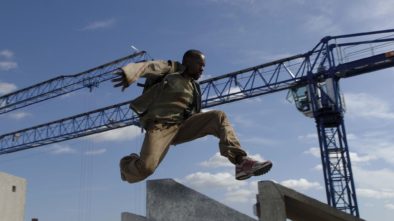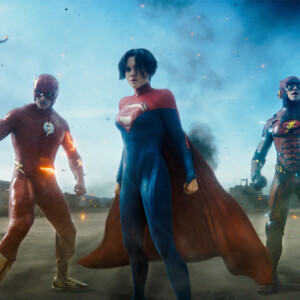Astro Spiral: The Greatest Car Stunt Was Also The World’s First Computer-Modeled Stunt
And it’s no surprise James Bond was behind the wheel
The corkscrew car jump in The Man With The Golden Gun is the coolest car stunt in any movie series. Following Bond tradition, the car stunt was done for real. No models or computer trickery. Well, to be honest, a computer was used but not in the way you might expect. This famous 1974 jump of an AMC Hornet X over a twisted, broken bridge was the first car stunt, or any stunt for that matter, to be extensively computer-modeled.
As you can imagine, making this car perform a barrel roll in midair and land on the other side on its wheels is pretty complex. The twisted ends of the bridge have to be elevated at just the right angle, the car has to hit the bridge at just the right speed, and perform the airborne barrel roll at just the right moment to ensure an elegant and safe landing. In a stunt like this, safety is top priority, but making Bond look good is also important.
Before we delve into how they did it, check out the stunt below. It was performed in just one take.
The moment would have been even better without the slide whistle, which undermines it. Still, the stunt is impressive. This is how they did it.
The First Computer Simulated Stunt
The world of stunt drivers is fairly small and well-connected. While working on Live and Let Die, stunt driver Joie Chitwood showed director Guy Hamilton a photograph of a car performing the corkscrew jump at The American Thrill Show in Houston. When Hamilton talked with Bond producer Albert R. Broccoli about the stunt, Chitwood was cut out of the loop. After watching footage of the so-called Astro-Spiral jump performed at the Houston Aerodrome, Broccoli got directly in touch with the stunt driver, Jay Milligan.
To add injury to insult, Broccoli called Milligan while he was in a hotel room with Chitwood. Chitwood, who had just informed Milligan that he was about to fly to Singapore to perform car stunts on The Man With The Golden Gun, was suddenly out of a job. It must have been a blow, not only because he lost his job, but because he also played a part in tests that led to the performance of the original stunt in Houston. Nonetheless, Milligan became the film’s stunt coordinator, and another stunt driver, Loren ‘Bumps’ Willert, performed the stunt for Golden Gun.
The stunt went on to earn a Guinness World Record for the first “astro spiral” stunt on film. While Willert received all the credit, it was the technical research and design that made the stunt possible in the first place.
The unsung hero in the creation of this stunt is Ray McHenry. In 1968, he was working at Cornell Aeronautical Laboratory (CAL), an institution known for developing the first scientifically validated crash-test dummies to prove the effectiveness of seatbelts. There, he designed computer simulations to predict car crashes.
“We were writing in FORTRAN,” McHenry said in 2011. “We had a roomful of IBM 360 computers with punch cards. We’d submit a stack of punch cards and wait overnight to see what the results were.”
The technology is archaic by today’s standards, but it proved effective in simulating crashes to help build safer roads. McHenry tested thousands of variables and theoretical situations, which he needed to test in a controlled, real-world situation. In 1970, the perfect opportunity arose when the Joie Chitwood Thrill Show arrived in Buffalo.
“I hired some of Chitwood’s drivers to expand our range of validation,” recalled McHenry. “I had them driving on two wheels, spinning, reversing, and jumping, doing more and more violent maneuvers driving our instrumented 1963 Fords. The spiral jump was an extension of that.”
The idea for a car performing a 360-degree spiral jump had been floating around auto thrill shows for years. McHenry, inspired by his involvement with Chitwood’s auto show, contacted Jay Milligan, who owned thrill show company, JM Productions. They both sat down and conceived of the spiral jump. McHenry worked out all the variables in his computer simulation and Milligan devised the real stunt which he’d perform at the American Thrill Show in 1972.
McHenry couldn’t run a proper simulation without knowing what car Milligan used. Milligan had a promotional agreement with American motors, and they wanted him to use their new sports car, the Javelin. Milligan took the car to General Motors, who measured everything.
This is where it gets technical, so stay with me.
McHenry took all the measurements and simulated the stunt using the equations of the 18th-century mathematician Leonhard Euler. Referring to the work of a centuries-old maths whiz seems odd, considering cars didn’t exist, but Euler’s equations for the motion of a rigid object moving through 3D space still stack up today.
“You define a reference coordinate system for a vehicle within the sprung mass,” explained McHenry, referring to his computer model of the AMC Javelin and its weight, “and a second coordinate system for space. Then you can measure the two coordinate systems rotating within each other. The differentials can be coordinated into milliseconds.”
For simpler understanding, picture two cubes, with the smaller one moving through the other. The goal is to measure the edge of each cube in relation to the other and to make sure they never collide.
“We integrate the degrees of freedom—six to define where the body is in space, plus yaw, pitch, roll, and Z, or downward motion,” McHenry continued. “You place the reference point—the center of the sprung mass—and you rotate it to the final yaw, final pitch, and final roll. That’s 10 independent variables. And to solve for those simultaneously we use matrix algebra.”
Maths was never my strong suit, but the easy explanation is:
Once the edges and volume of the car are determined, the computer program calculates the car’s movement. This movement is calculated from the moment the car launches off the jump to touchdown. Each rotation is recorded throughout the car’s spiral to give accurate variables for takeoff and touchdown. As long as no variable is miscalculated or missed and they follow the laws of physics, then they can finish off by designing a ramp that is angled so the car’s wheels will touch down at the end of its spiral for a safe landing.
These calculations determined that a 40-mph takeoff speed and a 1.5-second flight time between ramps would need about 200 degrees of rotation per second. It’s a pretty tricky process, and one slight miscalculation could be curtains for the stunt driver. So the CAL team calculated ramp shape and completed 32 simulated launches. From there, the team designed a landing ramp to catch the car. This was about 270-degrees in the car’s rotation to land it safely. A further 12 simulations locked these calculations in place.
They made further modifications to the ramp and car to make the stunt work. Part of the left side of the takeoff ramp dropped down after the front wheel passed over it. This was a necessary measure to prevent the rear wheel from touching because it would already be rotating as it reached this point. In addition, the Javelin’s rear differential was mounted with a steel wheel to tilt the rear of the car high enough to make a successful jump.
By November, the AMC javelin was ready for a series of unmanned tests. Each test was a success, and then on December 22, stunt driver Chick Galiano got behind the wheel and guided the Javelin through its first–and near-perfect–manned test. After two more successful manned tests, Milligan and McHenry shipped the Javelin to Houston to perform in the American Thrill Show.
The crowd went wild as the Javelin accelerated up the ramp and performed its planned 270-degree spiral jump. It wasn’t perfect. Milligan thought the jump was a bit too slow because of changes in the terrain. Death-defying car jumps were all the rage in the 1970s, ever since Evil Knievel dressed up as Elvis Presley and jumped the fountains at Caesar’s Palace in 1973. With their fingers ever on the pulse of public appeal, the James Bond producers were looking for something similar. They had already performed some cool car stunts through the streets of Las Vegas in a red Cougar in Diamonds Are Forever in 1971.
This time they’d ditch Vegas for the Far East, but keep the American car. After Milligan got the call from Bond producer, Albert R. Broccoli, he was off to Thailand. McHenry and CAL ran a new computer simulation to account for the slightly different dimensions of the AMC Hornet. The car was modified with a roll cage, fitted with a central steering position, and an “auxiliary contact point” was added to the rear axle. It was also equipped with two tachometers to help the stunt driver hit the ramp at exactly 48 miles per hour to make the jump.
The Astro Spiral jump would be the signature stunt in a car chase through the streets of Bangkok and Thailand’s countryside. The stunt would be performed across a river, with ramps disguised as the ends of a dilapidated bridge. On June 1, 1974, the 31st day of production, Loren “Bumps” Willert accelerated at perfect speed towards the ramp, and in one take he performed the auto spiral jump. No further takes were needed. Two dummies of Bond and Sheriff J.W. Pepper sat either side of Willert, who was dressed in black so the camera wouldn’t register him.
Even though the stunt was performed in the Thai countryside, Willert had an audience as if he was performing the stunt in the American Thrill Show. This is what they saw.
“Some people didn’t believe we actually did the stunts,” said marketing executive Hy Smith. “We took about 100 press from Europe in a rented 747 to Thailand. Despite that they saw the car corkscrew 360 degrees from one side of the river to the other, when the picture came out, many of them said it was the most wonderful special effect they’d ever seen.”
Roger Moore, in typical self-deprecating humor, told the stunt team: “You fellas make me look good.”




